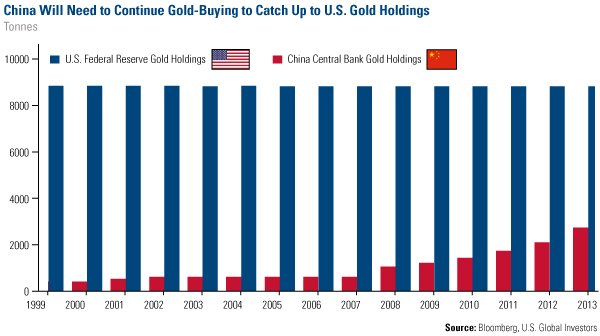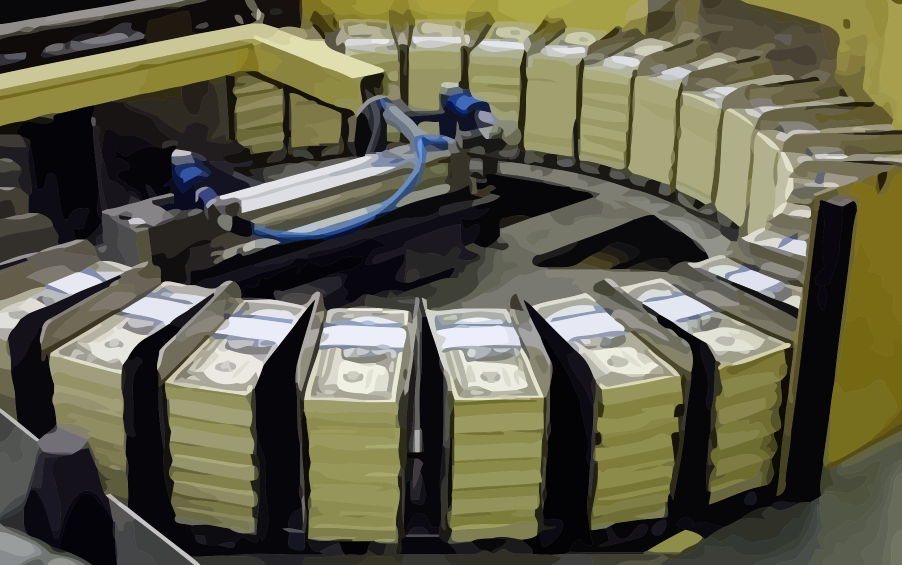Gold Market Radar (April 20, 2014)
For the week, spot gold closed at $1,295.00, down $23.42 per ounce, or -1.78 percent. Gold stocks, as measured by the NYSE Arca Gold Miners Index, lost 2.67 percent. The U.S. Trade-Weighted Dollar Index gained 0.52 percent for the week.
Strengths
- Gold demand in China is expected to rise about 25 percent in the next four years as the country’s increasing population gets wealthier, according to the World Gold Council. In the next six years, China’s middle class is expected to grow from 200 million people to 500 million people. Historically, China has a cultural affinity for gold, and when combined with an increasingly-affluent population and a supportive government, there is significant room for the market to grow further.
- Glencore Xstrata announced Sunday it has sold the Las Bambas copper mine to a Chinese consortium led by MMG Limited in a $5.85 billion cash deal, one of China’s largest mining acquisitions in recent years. The Chinese government refused to approve the merger between Glencore and Xstrata unless Las Bambas was sold to Chinese companies. China believes in copper, which is encouraging for the global copper-mining industry.
- Mandalay Resources reported first-quarter results, and was raised to “strong buy” from “outperform” at Raymond James by equity analyst Chris Thompson. Mandalay has a healthy dividend of 3.4 percent, providing investors down-side protection. Thompson also likes recently revised resources, which are accretive to net asset value (NAV). Recent production results indicate the company is on track to reach 2014 output of 3.0 to 3.2 million ounces of silver, 60,000 to 70,000 ounces of gold, and 3,000 to 3,300 tonnes of antimony.
Weaknesses
- Weak economic data out of China set a negative tone in the gold market for Tuesday’s trading session. The People’s Bank of China (PBOC) reported money supply growth decelerated to 12.1 percent year-over-year in March, a historic low, from 13.3 percent year-over-year in February. First-quarter GDP was reported at 7.4, which is the lowest growth in six consecutive quarters. Industrial production was reported at 8.8 percent versus Bloomberg’s expectation of 9 percent in a recent survey.
- The World Gold Council also noted that China’s gold jewelry demand in 2014 may not be as strong as last year, considering the price weakness seen in 2013. However, the demand outlook for 2015 to 2017 appears to be rosier than this year, especially given the expected increase in consumer real income and purchasing power.
- India’s general election has negatively impacted gold trade in the country. Gold traders in India are used to cash transactions when buying and selling gold. With the election code of conduct in force, traders face severe restrictions on carrying physical cash in large denominations. According to Hasmukh Bafna, President of the Gold Chains & Jewellery Welfare Association, business has dropped by 70 to 80 percent since the first week in March.
Opportunities
- We may see inflation moving higher, according to David Rosenberg, Chief Economist & Strategist at Gluskin Sheff. In a recent “Breakfast with Dave” publication, he wrote that no inflation seems to be the widespread consensus these days, but with the likes of coffee, orange juice, platinum and palladium prices hitting new highs, it may not be the case. The University of Michigan inflation expectation is at a seven-month high of 3 percent, and the current U.S. 10-year Treasury note is at 2.6 percent. This represents 39 basis points, a negative real rate when benchmarked against the inflation expectation metric. The metric is driven by shoppers who are more accurately in tune with pricing than most economists, especially the model-driven central bankers. According to a recent publication from the International Strategy & Investment (ISI) research team, inflation has likely bottomed. Commodity prices have been in a narrow-to-sideways pattern for the past three years, with a slight upside breakout recently.
- Recent data shows that Russia has now overtaken the U.S. to become the world’s second-largest gold producer behind China. Consider the following comments on the new ranking from Xinhua, an official government news agency in China, which states that perhaps it is a good time for a befuddled world to start considering a de-Americanized world. Key among its prospects are: (1) the creation of a new international reserve currency to replace the present reliance of the U.S. dollar, (2) a self-serving Washington has abused its superpower status and introduced even more chaos in the world by shifting financial risks overseas, and (3) such alarming days when destinies of others are in the hands of a hypocritical nation.
- China is now thought to hold 2,716 million tonnes of gold, while the U.S. holds 8,812 million tonnes. China would still need ten years for its gold holdings to catch up to the U.S., suggesting strong gold demand from China. With Russia on the offensive again, it too has the capacity to push oil prices higher, boost its revenue and purchase additional gold beyond domestic production.
- Palladium prices rose to the highest since 2011 on concerns that supply may be restricted due to escalating tensions over Ukraine and three months of strikes in South Africa. While interest in Standard Bank’s African Palladium ETF was flat at 66,000 ounces, Absa’s NewPall was up sharply last week from 32,000 ounces to 148,800 ounces. Palladium ETFs are likely to continue attracting significant inflows in the coming weeks, raising the prospects for even higher prices.
Threats
- Due to India’s severe restrictions on carrying physical cash in large denominations which were imposed on gold traders during the elections, several jewelers have stopped business until the elections are over. This low gold demand is expected to continue until the middle of May.
- The U.S. Court Appeals for the District of Colombia Circuit ruled that the U.S. Securities and Exchange Commission’s conflict minerals disclosure requirements are unconstitutional and remanded the matter to the district court for further consideration. Companies have already invested significant time and money into addressing this issue. The process is now in review and could entail new changes in the regulations, imposing additional cost burdens.
- On April 15, the price of gold dropped $25.35 or 1.91 percent. This was the one-year anniversary of the exact same day in 2013 when gold plunged the most in 33 years amid record-high trading. Goldman Sachs reiterated its forecast for the metal to end the year at $1,050 an ounce.















